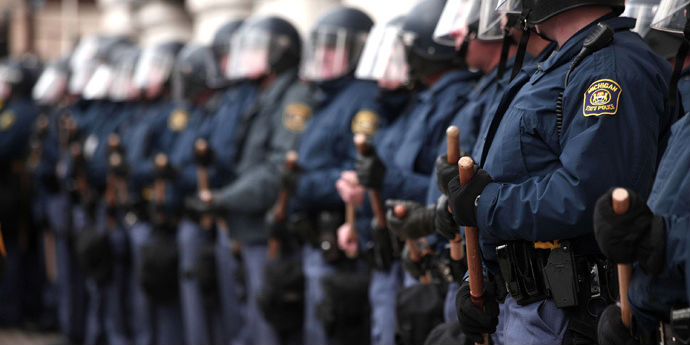The nation has focused on the St. Louis suburb of Ferguson, Missouri where a police officer shot and killed 18-year-old Michael Brown. He was an unarmed, African-American teenager who was walking to his grandmother’s house. No one who wasn’t there can honestly say what happened when Brown and his friend were confronted by Ferguson Police, except, as we know, Brown was killed by a still unidentified police officer.
Videos By Rare
The Brown killing has ignited riots and protests in Ferguson. The police had the FAA close the airspace over Ferguson to low-flying aircraft, even to news helicopters. The police have even threatened the media with arrest if they did not leave Ferguson. The hacker collective Anonymous threatened to release the personal information of the daughter of Ferguson’s police chief if the name of the officer who shot Michael Brown was not released. Ferguson police have refused to identify the officer due to concerns about the officer and his family.
The killing of Brown and another police shooting Tuesday in Ferguson reminds us of the clear and present dangers of police militarization. Reverend Jesse Jackson, in probably the only time I will quote him favorably, said that “there’s a Ferguson near you” in his USA Today op-ed on the Brown shooting, and although he wasn’t talking about the issue of police militarization, he’s right. Because of the proliferation of military-style weapons, armored vehicles, and even more dangerously, an antagonistic attitude of seeing themselves at war with the people they’re supposed to protect; police militarization has all but ensured that another “Ferguson” will happen again unless steps are taken to rein it in.
Police militarization began in the 1980s when the Reagan administration began giving state, local, and federal law enforcement access to military bases and training in order to fight the war on drugs. The George H.W. Bush administration created special regional task forces within the Pentagon to cooperate with police on anti-drug efforts.
The main culprit of police militarization is a 1994 law that allows the Pentagon to donate military surplus equipment to police departments. Since then, police departments have been flooded with weapons, vehicles, and uniforms whose place is on the battlefield and for policing an American street. The flow of arms and equipment to police departments has only increased since the 9/11 attacks. It is are likely to increase again as the ground wars in Afghanistan and Iraq come to an end and the excess equipment needs to be disposed of.
This is disturbing for a number of reasons, but prime among them is the fact that the roles of the police and the military are different. The military’s job is to simply destroy the enemy, while the police’s job is to enforce the law, but also to take care not to violate the constitutionally protected liberties and rights of suspects.
The military is trained to use overwhelming force where as the police are trained to only use deadly force only if they’re in imminent danger. The two mentalities are not the same because they do not have the same mission.
However, that has been changing as police training is emphasizing the “warrior mentality” instead of a guardian mentality that treats the community with dignity and respect. Part of the result of this “warrior mentality” can be found at the Cato Institute’s National Police Misconduct Reporting Project where there are near daily reports of police misconduct. African-Americans especially continue to distrust the police, even though the latest national homicide numbers reveal that African-Americans are the majority of the victims because they believe the police are at war with them.
It’s this mentality that can lead a Ferguson police officer to call protesters “animals” on Sunday night.
Everything from laws, oversight, and police training needs to change. The laws allowing the Pentagon and Homeland Security Department to essentially handout weapons of war to police departments needs to be changed to require an actual need for these automatic weapons and armored vehicles and to require matching funds from local governments so local governments will have to justify this type of expenditure to its residents.
There needs to be national standards for police misconduct passed by Congress and enforced by the Justice Department. The FBI is investigating the Michael Brown shooting and that’s the right thing to do. Why involve the federal government instead of just letting the Internal Affairs divisions of police departments enforce it? Because as A.J. Delgado of National Review Online pointed out in her excellent piece on police brutality last month, Internal Affairs itself often acts like that police officers are above the law.
Police training needs to move away from the military mindset of the warrior and get back to a mindset of serving, protecting, and more importantly being a part of the community instead of being at war with it. Finally, local governments should consider abolishing police unions.
We also need to reexamine the war on drugs and the war on terror, asking ourselves whether these wars do more harm than good–and whether our efforts continue to do more longterm damage than even drugs or terrorists.

